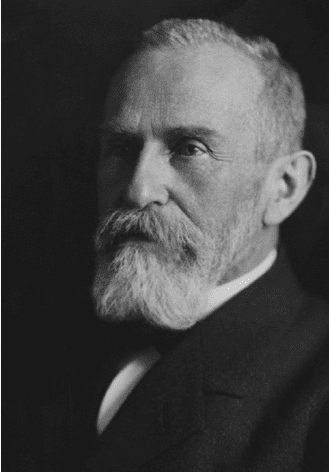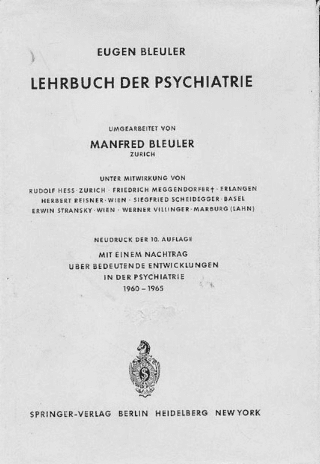JMS Pearce
East Yorks, England, United Kingdom
 |
| Fig 1. Eugen Bleuler, 1900. from: G. Wehr, Jung, ed. René Coeckelberghs, Collection Les Grands Suisses, ISBN=2-8310-0009-2. Clinique du Burghölzli. |
Paul Eugen Bleuler (1857-1939) (Fig 1) was one of the most influential psychiatrists of his time, best known today for his introduction of the term schizophrenia to describe the disorder previously known as dementia praecox.
In the second half of the nineteenth century, psychological medicine was in its infancy. Two concepts prevailed. First, that severe mental illness was a unitary psychotic entity that Wilhelm Griesinger (1817–1868) called Einheitpsychosis in 1861. Secondly, that psychological symptoms could be caused by organic brain disease, best illustrated by syphilitic General Paralysis of the Insane. Emil Kraepelin (1856-1926) refuted the unitary notion and established two distinct disorders: dementia praecox and manic-depressive insanity. Meanwhile, Freud (1856-1939), though trained in organic neurology, was quite separately inventing psychodynamic theory, which spawned its own vocabulary and culminated in psychoanalysis. Kraepelin, Freud, and Bleuler were born within a year of each other.
Eugen Bleuler was raised in rural Zollikon, on the shore of Lake Zurich and read medicine in Zurich, graduating MD in 1883. He trained and studied in Paris with Charcot, and with Bernhard von Gudden in Munich. In 1885, he became assistant physician in Burghölzli, the Psychiatric University Hospital, Zürich. A year later, aged only twenty-nine, he was appointed director of the Rheinau Psychiatric Hospital where he lived with and cared for long-term psychiatric patients until he returned to Zurich as professor of psychiatry at Burghölzli in 1898, a position he held until his retirement in 1927. Eugen Bleuler died in Zollikon, his birthplace, in July 1939.
Whereas Kraepelin had collected information about his patients from their records and follow-up studies, Bleuler relied on careful clinical observations, “practically living with his patients.”1 Bleuler derived his terminology from the Greek words schizein meaning split, and phren the soul, or mind. He first introduced the term schizophrenia on April 24, 1908, when he gave a lecture at a meeting of the German Psychiatric Association in Berlin. Based on a study of 647 Burghölzli patients, he argued that dementia praecox was associated with neither dementia nor precociousness; he emphasized a splitting of psychic functioning as its essential feature.
“I wish to emphasize that in Kraepelin’s, dementia praecox it is neither a question of an essential dementia nor of a necessary precociousness. For this reason, and because from the expression dementia praecox one cannot form further adjectives nor substantives, I am taking the liberty of employing the word schizophrenia for revising the Kraepelinian concept. In my opinion the breaking up or splitting of psychic functioning is an essential symptom of the whole group . . .” (Translation from3)
He recognized that dementia was not the inevitable consequence of dementia praecox, as Kraepelin had suggested.2 It was not a single disease, nor invariably progressive or incurable. He expanded his work in a monograph of 1911 Dementia Praecox or The Group of Schizophrenias.3,4 With Emil Kraepelin’s Compendium der Psychiatrie (first edition 1883) it remains the best description of madness at the turn of the twentieth century.
 |
| Fig 2. Bleuler’s Lehrbuch der Psychiatrie. |
Psychopathology of schizophrenia
Kraepelin had largely ignored the notion of psychogenic reactions to stress and the importance of individual personality traits in the symptoms of dementia praecox; they which were subsequently elaborated by Adolf Meyer. To the empathetic Bleuler, schizophrenic symptoms were a disordered train of mental associations and splitting or fragmentation of the personality.5 It was a primary but ill-defined neurobiological disease with disordered thought, delusions, and hallucinations, but framed and compounded by secondary psychological factors.
He introduced two new concepts fundamental to the analysis of schizophrenia: 1. autism, denoting withdrawal, a loss of contact with reality, frequently through bizarre fantasy;a and 2. ambivalence, the coexistence in thinking of mutually exclusive contradictions such as love and hate.
Each of these features was at odds with the accepted wisdom of the time. He believed that both brain and mind, as well as social factors were equally important elements in mental illness. Manfred Bleuler, his eldest son, and Rudolf Bleuler his grandson, amplified these notions.6
Bleuler and Freud
Bleuler had lengthy discussions and letters with Freud. He was an early supporter of Josef Breuer and Freud’s Studies on Hysteria and introduced Freud’s psychoanalytic ideas into the Burghölzli, with which he tried to understand the symptoms of schizophrenia. Indeed Freud, referring to the Burghölzli in Zürich commented:
Nowhere else had a public clinic been placed in the service of psycho- analytic research or an academic clinician accepted psychoanalytic ideas as an integral part of psychiatric teaching.7
Bleuler accepted Freud’s notion that certain mental processes could be unconscious, but in schizophrenia he realized that the dissociation of thinking was primary and independent of the unconscious mind.8 He was persuaded that schizophrenia could have secondary psychological mechanisms. This challenged the prevailing belief that it was entirely organic.9 Bleuler and his famous assistant Carl Jung were members of the newly formed Vienna Psycho-Analytical Society. Bleuler later withdrew after finding Freud’s ideas too dogmatic, and his methods of hypnosis ineffective in relieving schizophrenic symptoms. Nonetheless there remained a continuing mutual respect; indeed, Bleuler remarked: “we owe the ‘greatest advance’ (größten Fortschritt) in psychology and psychopathology to Freud, and his enemies have long since been unable to avoid his influence.” He recommended Freud for the Nobel Prize in 1937.
Modern psychiatrists agree that psychological factors do not precipitate but may aggravate established schizophrenia. Schizophrenia remains a variable clinical syndrome of protean etiology with essential psychological characteristics. These are primarily irrational disorders of thinking, emotions, and volition with catatonic “psychomotor” symptoms, and secondary delusions and hallucinations.10
Bleuler also published articles on alcoholism, and on hypnotism, aphasia, and idiocy. His Lehrbuch der Psychiatrie, 1916 (Fig 2) became a standard text and went through many editions—the thirteenth revised by Manfred Bleuler in 1975.
Bleuler was a critical scientist, who criticized empirical claims for new treatments. He proposed: “for almost all conclusions the degree of their probability should be determined, if possible expressed in numbers.” He regarded negative results as important as positive ones: “for in science there are no negative results.”11 He advocated strictly controlled trials with a placebo group—essentially evidence-based medicine.12
In 1901 he married Hedwig Waser; they had five children including Manfred, who was to become Professor of Psychiatry in Zurich. His granddaughter described him as a kindly man, utterly devoted to patients and family. He was frugal in his habits, intent on a moral and responsible life, but with little interest in religion. In his pockets, he carried a notebook and sheets of notepaper on which he methodically recorded observations and ideas for later use.13
Amongst his distinguished students were Karl Abraham, Ludwig Binswanger, Carl Jung, and Eugene Minkowski.
End Note
- Note how this differs from the modern definition of “A neurodevelopmental condition . . . chiefly characterized by difficulties with social interaction and communication and by restricted or repetitive patterns of thought and behaviour.” (Merriam Webster)
References
- Ashok AH, Baugh J, Yeragani VK. Paul Eugen Bleuler and the origin of the term schizophrenia (Schizopreniegruppe). Indian J Psychiatry. 2012;54(1):95-96.
- Pearce JMS. “Modern psychiatry begins with Kraepelin.” Hektoen International 2021.
- Bleuler E. Dementia praecox oder die Gruppe der Schizophrenien. Leipzig. Wien, F. Deutsche 1911. In: Dementia Praecox or the Group of Schizophrenias. Zinkin J, translator. New York, NY. International Universities Press 1950.
- Kuhn R., Cahn CH. Eugen Bleuler’s concepts of psychopathology. Hist Psychiatry. 2004;15:361–366.
- Hoff P: Eugen Bleuler’s Concept of Schizophrenia and Its Relevance to Present-Day Psychiatry. Neuropsychobiology 2012;66:6-13.
- Bleuler M., Bleuler R. Books reconsidered. Dementia praecox oder die Gruppe der Schizophrenien: Eugen Bleuler. Brit J Psychiatry. 1986;149:661–664.
- Freud S. (1914) On the history of the psychoanalytic movement. SE (London: Vintage, 2001), XIV, 7–66.
- Dalzell TG. Eugen Bleuler 150: Bleuler’s reception of Freud. History of Psychiatry 2007; 18(4): 471–482.
- Fusar-Poli P, Politi P. Paul Eugen Bleuler and the Birth of Schizophrenia. (1908) Am J Psychiatry. 2008;165:1407.
- Mayer-Gross Slater E. Roth M. Clinical Psychiatry. 3rd edn by Slater & Roth. Baillière, Tindall & Cassell, London 1969, pp. 261-2.
- Bleuler E. Das Autistisch-Undisziplinierte Denken in der Medizin und Seine Űberwindung. [Autistic and undisciplined thinking in medicine, and its overthrow.] Auflage. Berlin: Springer, 1922.
- Stam J, Vermeulen M. Eugen Bleuler (1857–1939), an early pioneer of evidence based medicine. J Neurol Neurosurg Psychiatry 2013;84:594–595.
- Joos-Bleuler T. Being a member of the Bleuler family. Schizophr Bull.
JMS PEARCE, MD, FRCP, is emeritus consultant neurologist in the Department of Neurology at the Hull Royal Infirmary, England.
Summer 2021 | Sections | Psychiatry & Psychology

Leave a Reply